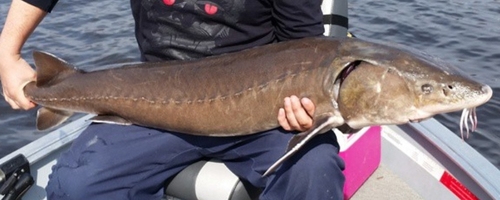
Lake Sturgeon
The Atlantic Bluefin Tuna (Thunnus thynnus) is a highly migratory, large pelagic fish known for its size, speed, and commercial value. This species plays a critical role in the marine ecosystem and is a top predator in the Atlantic Ocean. It is one of the most sought after fish.
50 150 years
Lifespan
200 - 300 cm
Length
Endangered
Conservation Status
32 km/h
Swimming speed
Omnivorous
Diet
Local Migration
Migration
Appearance Overview
The Atlantic Bluefin Tuna is renowned for its large, torpedo-shaped body, built for speed and endurance. It exhibits a dark blue dorsal side and a silvery-white underside.
Color
Dark metallic blue on top, silvery-white on the belly
Fin arrangement
Two dorsal fins, the first depressible; a series of small finlets behind the second dorsal and anal fins
Body shape
Torpedo-shaped, streamlined for efficient swimming
Length
Up to 13 feet (4 meters)
Weight
Up to 2,000 lbs (907 kg)
Diet
Carnivorous, feeding on a variety of fish, squid, eels, and crustaceans.
Feeding Behavior
Highly active predators, they use their speed and agility to chase down prey. They are also known to hunt cooperatively, herding smaller fish into tight balls before attacking.
Social Behavior
Typically forms large schools, especially during migration and spawning. Schooling behavior can vary by age and size, with larger individuals sometimes found alone.
Commercial Relevance
Extremely high value, particularly in sushi and sashimi markets, where its fatty flesh is considered a delicacy. This demand drives significant fishing pressure.
Conservation measures
Subject to international and national management measures, including fishing quotas, size limits, and seasonal closures. Efforts also include tagging programs to monitor populations and migration patterns.
Status
Endangered
Threats
Overfishing is the primary threat, driven by high demand in international markets. Other threats include bycatch in fishing gear and habitat degradation.
Habitat Distribution
Depth Range
0-1,000 meters, though they are most commonly found in the upper layers of the ocean.
Geographic Range
Found throughout the North Atlantic Ocean, including the Mediterranean Sea, and the Gulf of Mexico.
Preferred Environment
Pelagic, open ocean environments; they prefer temperate waters but can range into both colder and warmer areas.
Reproduction and Life Cycle
Breeding Habits
Spawns in two main areas: the Mediterranean Sea and the Gulf of Mexico. Spawning typically occurs in warm waters during specific seasons.
Development Stages
Eggs hatch into larvae, which develop rapidly in plankton-rich waters. Juveniles grow quickly, reaching significant size within their first year.
Fecundity
Highly fecund; females can produce up to 30 million eggs per spawning season.
Maturity Age
Reaches sexual maturity at around 4-8 years, though this can vary by location and population.
Faqs about Lake Sturgeon
Where can you find Atlantic Bluefin Tuna?
Atlantic Bluefin Tuna are found in the Atlantic Ocean, ranging from the cold waters of the North Atlantic to the warmer tropical waters of the Gulf of Mexico and the Mediterranean Sea.
How long do Atlantic Bluefin Tuna live?
They can live up to 40 years, though many are caught before reaching this age due to fishing pressure.
Are Atlantic Bluefin Tuna warm-blooded?
Yes, they are warm-blooded, able to maintain a body temperature higher than the surrounding water, which aids in their speed and endurance.
What is the biggest threat to Atlantic Bluefin Tuna?
The biggest threat is overfishing, primarily due to their high value in the sushi market. This has significantly depleted their populations.
How are Atlantic Bluefin Tuna populations managed?
They are primarily managed through international agreements and fishing quotas set by organizations like the International Commission for the Conservation of Atlantic Tunas (ICCAT).
What role do Atlantic Bluefin Tuna play in the ecosystem?
They are apex predators, feeding on a wide range of fish, squid, and crustaceans. This helps control the populations of their prey species.
Do Atlantic Bluefin Tuna migrate?
Yes, they undertake long migrations across the Atlantic Ocean, often traveling thousands of miles between feeding and spawning grounds.
How many eggs can a female Atlantic Bluefin Tuna lay?
Females can release millions of eggs during a single spawning season, contributing to their potential for rapid population growth if properly managed.
How fast can Atlantic Bluefin Tuna swim?
They are known for their incredible speed, reaching bursts of up to 40-50 mph when chasing prey or avoiding predators.
Copyright @ Nature Style Limited. All Rights Reserved.
 English
English